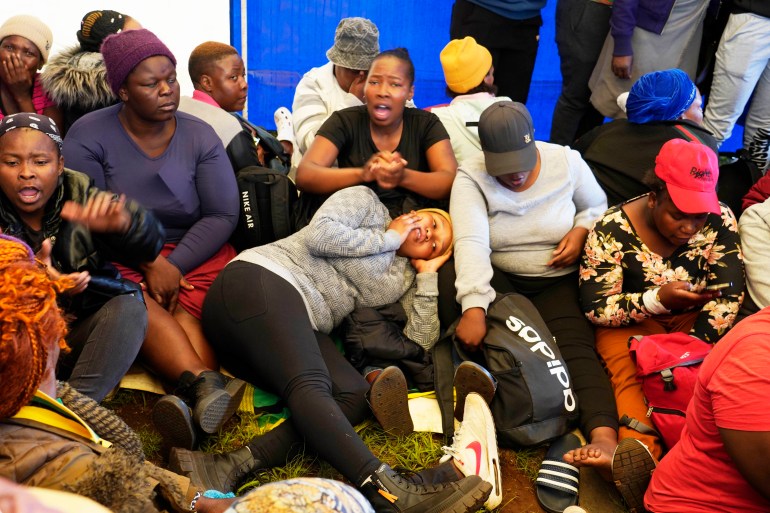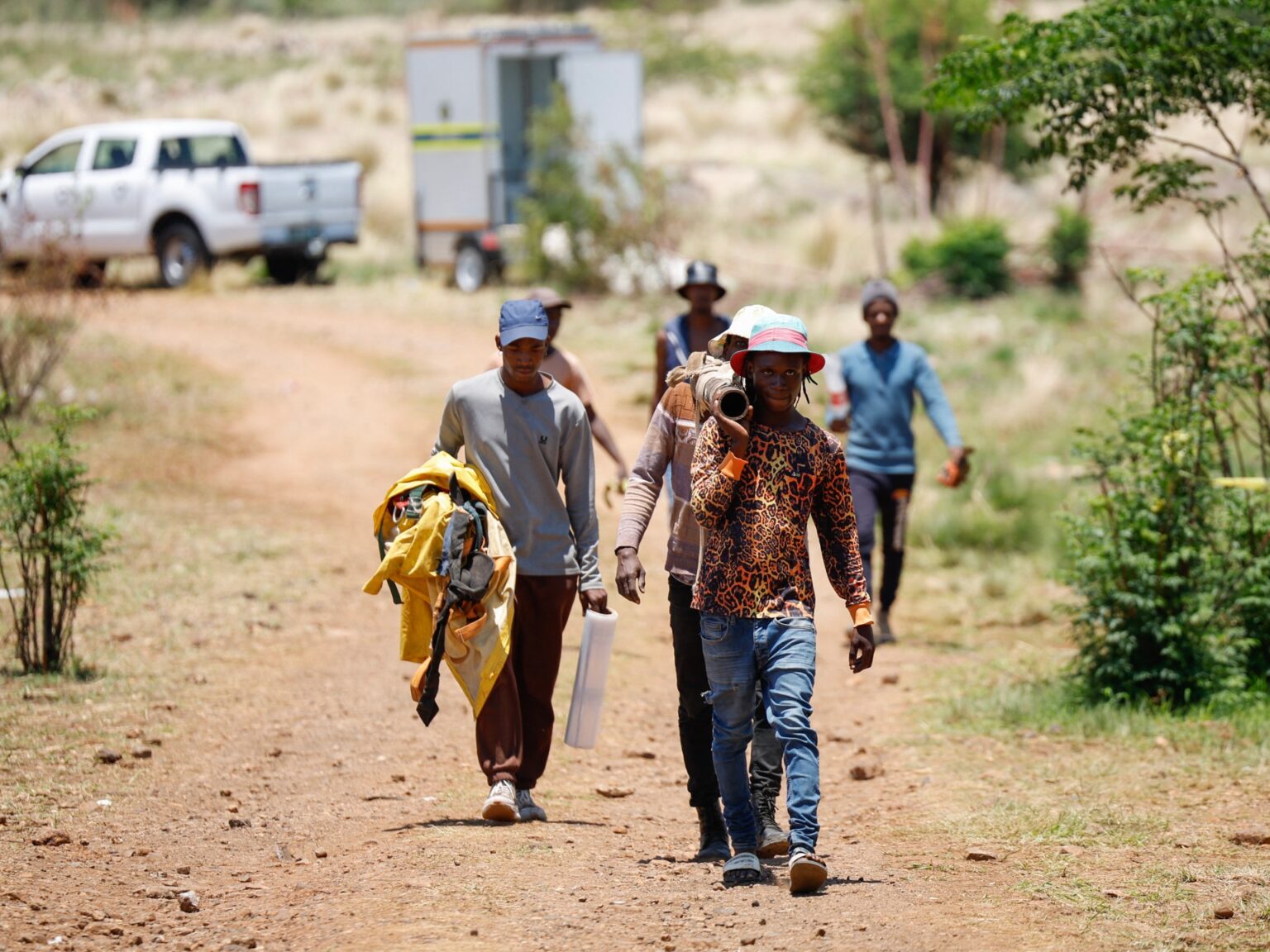South African police this week arrested a group of 14 people who resurfaced from a gold mine that’s at the centre of a tense, weeks-long standoff between unauthorised miners and authorities in the northwestern town of Stilfontein.
The men were arrested Sunday night after emerging from one of the mine’s shafts or entrances. A teenage boy was among them and bore visible wounds.
Hundreds – possibly thousands – of people, are believed to be holed up in the vast tunnel network, without adequate food or water. The miners are fearful of coming out of hiding as they face arrest or deportation, officials have said.
Illegal gold mining is widespread in South Africa, a one-time mining giant. Thousands routinely search for gold deposits in abandoned mines that are no longer deemed viable or safe. More than $1bn is lost annually in revenue because of illegal mining, according to the South African government.
Authorities have increasingly taken a hard line, cracking down on miners, called “zama zamas”. Police are blocking off mine shafts, in attempts to force out and arrest the miners.
Here’s what to know about illegal mining in South Africa and the Stilfontein standoff:
What’s illegal mining in South Africa?
Informal miners have for decades combed once functional South African gold mines looking for gold deposits or other precious metal deposits. The sites are officially closed or have had mining halted because they were deemed unsafe or non-viable.
Zama zamas operate in some 6,000 disused mines, some of which have connected tunnels or shafts. Mining companies in the past dug vertical tunnels deep underground to reach gold. Unauthorised miners travel into these old, often unstable shafts, and use basic materials like picks and buckets to scoop gold ore.
Miners tend to remain in the mines for long periods, over months sometimes, looking to hit gold and make money. They rely on help from contractors outside who pull them up for a fee. These contractors also supply the miners with food, water, cigarettes and other items by lowering them into the ground. There is an entire economy underground, with food and good prices sold at super high rates.
The illegal trade is controlled by criminal syndicates that fight one another in gang wars or attack the police. Most zama zamas though, are undocumented migrants from Zimbabwe, Lesotho, and Mozambique, and many are believed to be exploited by the gangs.
Gang members hold some miners at gunpoint in the mines and force them to dig for gold in some cases, according to reports over the years. They also force the miners to pay for their food and water underground.
What led to the present standoff?
Last December, South Africa’s police and military jointly launched the operation “Close the Hole” or “Vala Umgodi” in Zulu. The strategy involves closing off shafts or entrances, cutting off provisions from outside, and forcing miners out of the ground.
In September, police surrounded the site in Stilfontein, including Shafts 10 (also called Margaret) and 11, which are approximately three to five kilometres (1.9 – 3.1 miles) from each other on the surface.
Officials prevented food or water from being lowered into the mine for several days and also prevented volunteer emergency workers from accessing the trapped miners. Family and community members gathered around the site, pleading for an official rescue mission, but authorities did not agree to one.
However, about two weeks later, a court judgement forced police to allow community members to send down food and to pull some men up with ropes from Shaft 11.
It was a slow process, and it took up to an hour to pull one person up. The volunteer rescue mission was discontinued after a dead body was sent up. Some 12 people were pulled up, in total. Officials also did not allow any more food to be provided.
Authorities believe the two shafts are connected and together hold between 350 and 400 miners. However, one volunteer community member, who was lowered into one of the shafts two weeks ago, said up to 4,000 people are underground.

What happened on Sunday?
A teenage boy and 13 other men were among those who emerged from Shaft 10 on Sunday night. Officials claim the men tried to “run back” when they saw that the police were stationed there.
All of the returnees looked visibly dishevelled, and some had wounds on their bodies. It took them a week to crawl through the tunnels and exit from the shaft, the men told Al Jazeera reporter Malcolm Webb, who was at the site.
The men told police authorities there were 10 heavily armed guards from Lesotho overlooking some 700 people holed up underground.
“When I wanted to leave I was threatened with a gun. People are dying of hunger down there because the bosses don’t want people to come out,” one man told Al Jazeera.
The men said those they left behind were in much poorer conditions because they had no food or water.
“They are on the brink of death … some are already dead. In a week or two weeks’ time, it’s going to be disastrous down there,” the man said.
However, police officials believe that the miners can emerge voluntarily and are not in forced distress.
“The mere fact that they have been able to come out, it just goes to show that there was no one that was trapped,” police spokesperson Athlende Mathe told reporters.
Is the government planning a rescue mission?
Yes, the government has taken over from the volunteer group of men who were pulling people out from one of the mine shafts. That mission stopped once a dead body was sent up. It’s not clear how the man died.
Officials say they are now looking at the different possibilities of an assisted evacuation. On Sunday, a crew dropped cameras and monitors into one of the shafts to assess the number of people there and the safety levels of the shaft. However, the results are still being processed.
A major fear officials have cited is that criminal syndicates underground could be armed, and that would pose a danger to government rescue teams.
Authorities also say the mine could contain poisonous gases, posing another risk to official rescuers.
One plan provincial authorities are considering is to send down a cage into the mine to bring a few people at a time to the surface. However, the safety of such an operation is still being assessed.
On Monday, a Pretoria High Court dismissed an application by the civil society group, Society to Protect Our Constitution, which sought to force authorities to allow more supplies to be sent to the miners.
Police authorities welcomed the ruling, and reiterated that the miners are not trapped but are rather refusing to come out to avoid arrest.
Read the full article here

